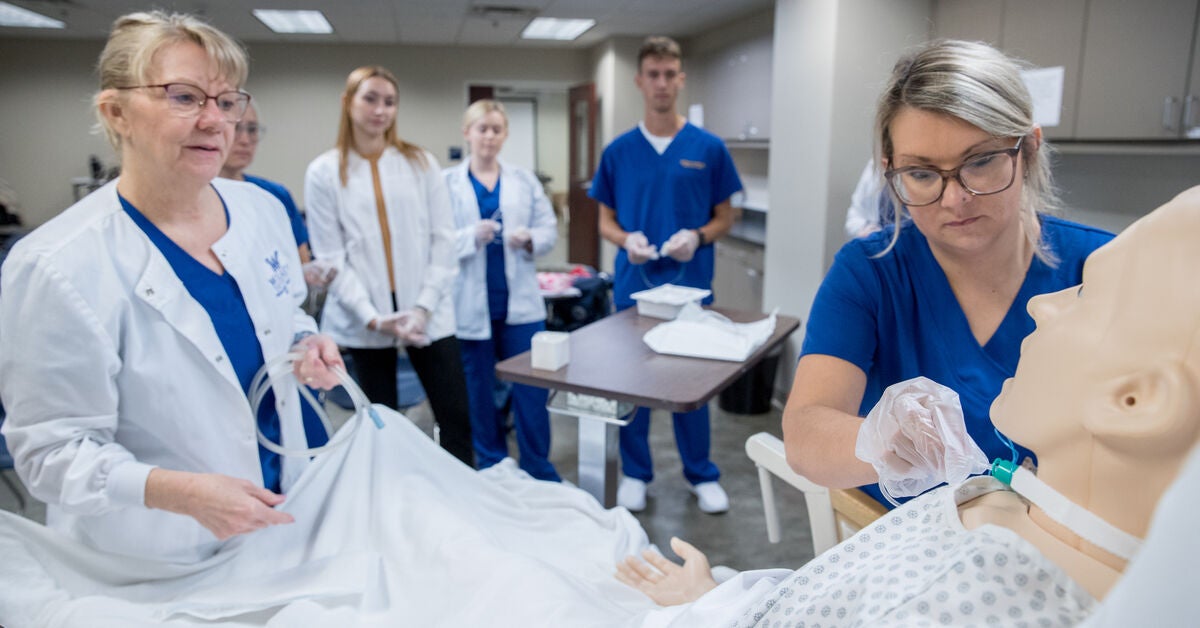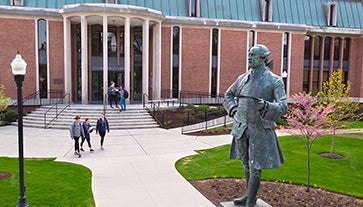
A physician assistant (PA), sometimes called a physician associate, is a type of medical provider, similar to the advanced practice nursing role of a nurse practitioner (NP). While these occupations share some comparable responsibilities, there are also key differences between the two professions. This article will explain more about characteristics of an NP vs. PA to help you decide which path may be right for you.
What is a Physician Assistant?
A physician assistant works interdependently with a physician to provide advanced medical care to patients of all ages. PAs have autonomy in some patient care activities and collaborate directly with doctors in others, with their scope of practice governed by rules and regulations at the state level. Physician assistants are certified nationally, with their license under a physician in their state. Their scope of practice is related to their supervising physician’s practice.
Licensed PAs are nationally certified by the National Commission on Certification of Physician Assistants (NCCPA) to ensure the highest standards of education and quality in offering medical care to the public. PAs frequently work in primary care but are not limited to this practice setting. The main difference between a PA and NP is the educational background required to enter each profession.
What is a Nurse Practitioner?
A nurse practitioner must be trained and licensed as a professional nurse (RN) before beginning advanced practice nursing education. With a nursing background, NPs have foundational skills in assessing and managing patients at the bedside. They are experienced in patient education and advocacy before learning how to deliver health care as primary or acute care providers.
National certification as a nurse practitioner is offered through the American Nurses Credentialing Center (ANCC) and the American Academy of Nurse Practitioners Certification Board (AANPCB). NPs receive education in a chosen specialty area and are certified at the national level. Examples of NP specialty areas include:
- Family Nurse Practitioner (FNP)
- Adult-Gerontology Primary Care Nurse Practitioner (AGPCNP)
- Adult-Gerontology Acute Care Nurse Practitioner (AGACNP)
- Pediatric Primary Care Nurse Practitioner (PPCNP)
- Pediatric Acute Care Nurse Practitioner (PACNP)
- Neonatal Nurse Practitioner (NNP)
- Psychiatric Mental Health Nurse Practitioner (PMHNP)
- Women’s Health Nurse Practitioner (WHNP)
In the United States, both PAs and NPs are helping to make a meaningful difference in the availability of quality health care providers.
PA vs. NP: Roles and Responsibilities
You may find physician assistants and nurse practitioners working in very similar patient care roles. It is common to find that the roles and responsibilities of PAs and NPs overlap. PAs are trained to conduct the following types of activities:
- Obtain comprehensive medical histories
- Complete thorough physical examinations of patients across the lifespan
- Perform medical procedures
- Order and interpret results of laboratory testing and diagnostic imaging
- Treatment of illnesses and counseling patients
NPs, like PAs, practice under the governing authority of state rules and regulations. Some states mandate the collaborative practice of NPs with physicians, while others continue to expand practice autonomy for NPs. Currently, more than half of the states in the country allow NPs the opportunity for full practice, including the ability to:
- Initiate diagnostics and treatment options for patients
- Prescribe medicines including controlled substances
- Conduct comprehensive physical examinations
- Evaluate patients and manage acute and chronic disease processes
Nurse practitioner skills are both clinical and non-clinical. The ability to evaluate research evidence for application to practice is a way NPs serve as leaders. Excellent communication and organization help NPs effectively carry out the administrative aspects of their roles.
PA vs. NP: Education
A major distinction between the nurse practitioner vs. physician assistan pathways is the educational background and training required to prepare these clinicians. The education for a PA follows a medical model with classroom and laboratory or simulation experiences as well as intensive clinical practice. PAs are taught to become expert generalists with knowledge of family practice medicine and instruction in a wide range of specialty areas.
Alternatively, NPs complete formal education in nursing to become registered nurses (RNs) who are then trained to become seasoned clinicians through additional education in diagnostics and prescribing at the master’s or doctoral level.. NPs may specialize in a variety of specific areas where they use critical thinking with a nurse-provider mindset to partner with patients and families in managing both common and complex health conditions.
If an NP has completed a master’s degree in one nursing specialization and desires to add another specialization, a post-master’s nurse practitioner certificate can allow working NPs to add a second specialty area to their credentials. Many of these programs are also offered in flexible, online learning environments.
PA vs. NP: Work Settings
There is substantial variability in the work settings of PAs and NPs. Physician assistants can be found working in outpatient clinics and hospitals, but also may be located in settings such as:
- Public and community health agencies
- Health management organizations (HMOs)
- Correctional facilities
- Nursing homes
- Rural and urban practices
- Research and health education
Likewise, NPs can be found in similar work settings. These include:
- Hospital units
- Ambulatory clinics
- Colleges and universities
- Public and community health
- Home health and hospice
- Pediatric clinics
- Obstetrics and gynecology
- Mental health and substance abuse clinics
The versatility of PA and NP work environments along with the variations in part-time and full-time commitments make it possible to find positions that are suitable for many diverse personalities and lifestyles.
PA vs. NP: Career Outlook and Salary
There is a growing demand for NPs and PAs to help supplement a shortage of physicians. The career outlook for both professions is positive with many job openings available.
According to the Bureau of Labor Statistics, a projected 28% job growth is expected for physician assistants between 2021 and 2031. This is substantially higher than other professions. Likewise, jobs for nurse practitioners are projected to grow at an even higher rate of approximately 40% between 2021 and 2031.
The median pay for physician assistants in 2021 was approximately $121,530 annually. This is comparable to the median pay for nurse practitioners and other advanced practice nurses at approximately $123,780 annually.
The top-paying industries for both physician assistants and nurse practitioners are as follows:
- Outpatient centers
- Hospitals
- Offices of physicians
- Government sector
- Educational services
Now is an excellent time to consider becoming an NP or PA, with excellent employment prospects that are anticipated to continue. Next, let’s answer some frequently asked questions about the PA vs. NP degree paths.
PA vs. NP: FAQs
Some of the most frequently asked questions about the NP and PA career paths are about how to become one. An online master of science in nursing - nurse practitioner program is offered to current RNs seeking graduate-level training to become an NP. To become a physician assistant, you would typically complete a master of science in physician assistant studies (MSPAS).
Both the NP and PA degree paths require clinical experiences to graduate. Both career paths require graduates to pass the respective national board certification examinations and complete ongoing professional development activities to maintain certification and state licensure.
PA vs. NP: Summary of Key Differences
There are more similarities than differences between the NP and PA roles, but the differences are important to understand when choosing the option that is best for you. The table below summarizes the key differences.
|
Nurse Practitioners |
Physician Assistants |
|
Educational background is in nursing followed by additional advanced clinical training to become a practitioner. |
Educational background follows the medical model and trains graduates to provide medical care alongside physicians. |
|
NPs have two main national certification organizations (ANCC and AANPCB). |
PAs have one main national certification organization (NCCPA). |
|
The selection of an NP specialization guides both curriculum and practice. |
A focused curriculum trains PA graduates to be professional, medical generalists. |
Save Time and Money with an NP Degree From Wilkes University
Wilkes University offers rigorous programs of study that can be completed on quick timelines at competitive prices. Ambitious working nurses can study without having to put their careers on hold. Getting an MSN degree is possible with options for a variety of educational backgrounds and prior work experience.
Pass rates for the NP board examination are consistently above average for graduates of Wilkes University. As a student, you will receive complimentary clinical placement support, affordable tuition, and flexible scheduling with multiple start dates available each year. You can become an NP with an MSN from Wilkes University, and it is possible to complete the MSN program in as little as 24-28 months.
Learn more about Wilkes’ online nurse practitioner programs, which have entry points for associate’s, bachelor’s, and master’s degree holders.





